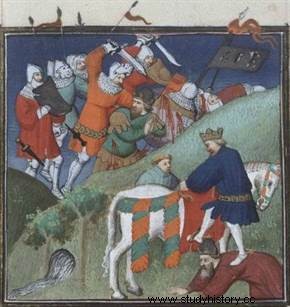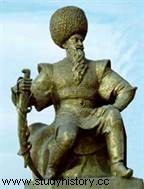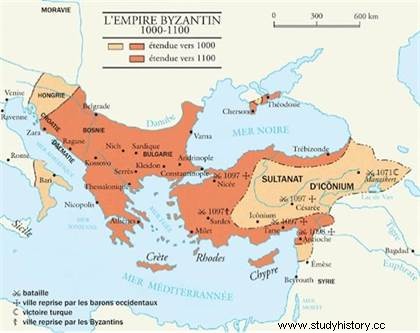 The Battle of Manziker t (1071) pitted the Byzantine army of Roman Emperor IV against the Seljuk Turks commanded by Alp Arslan. Victorious, the latter seized almost all of Asia Minor. Among the reasons invoked to justify the First Crusade, the Turkish conquest in the East figures prominently. First slaves within the Abbasid armies, the Turks gained political importance during the tenth century, and some of them, thanks to the title of sultan given by the caliph, succeeded in carving out principalities and to extend Turkish influence to Syria and Anatolia. Among these Turkic peoples, the Seljuks, who during the 11th century asserted their authority over the region, going so far as to threaten Byzantium. It was precisely this struggle between the Seljuks and the Byzantines that culminated in the Battle of Manzikert . For what consequences?
The Battle of Manziker t (1071) pitted the Byzantine army of Roman Emperor IV against the Seljuk Turks commanded by Alp Arslan. Victorious, the latter seized almost all of Asia Minor. Among the reasons invoked to justify the First Crusade, the Turkish conquest in the East figures prominently. First slaves within the Abbasid armies, the Turks gained political importance during the tenth century, and some of them, thanks to the title of sultan given by the caliph, succeeded in carving out principalities and to extend Turkish influence to Syria and Anatolia. Among these Turkic peoples, the Seljuks, who during the 11th century asserted their authority over the region, going so far as to threaten Byzantium. It was precisely this struggle between the Seljuks and the Byzantines that culminated in the Battle of Manzikert . For what consequences?
The Seljuks masters of the Muslim East?
The Turks were in Islam, until the 11th century, military slaves (Mamluks ). From the 9th century, they formed the bulk of the Caliphate Guard and their wives populated the harems of Baghdad. It was then different nomadic Turkish peoples who began to settle in the Muslim East, entering the service of the Caliph and becoming Islamized. The Abbasid caliphate was weakened in the 10th century, and soon under the tutelage of the Buyid Shiites, which facilitated the installation of the Turks. Some of the latter take important places within the army, but also in the administration, sometimes with the title of vizier.
Among the Turkic peoples who become influential during the 11th century are the Oghuz, led by Seljuk (who will therefore give his name to the dynasty). During the 1030s, they undermined the domination of the Ghaznavids and the Buyids in the East, and in 1055 they imposed themselves by force as protectors of the Abbasid caliph al-Qâ'im, when their sultan Tughrîlbeg (or Tuğrul Bey) entered Baghdad. They hold de facto power, driving the Buyids out of the Abbasid capital.
However, the Seljuk push does not stop in Iraq. Tuğrul Bey's successor, Alp Arslân (sultan in 1063), pushed aside his rivals and advanced even further west, in particular towards Anatolia. It also threatens Syria and the possessions of the rival caliphate of Baghdad, that of the Fatimids of Cairo. On the eve of the battle of Manzikert, the Seljuks are therefore in full swing with their conquering spirit.
A weakened Byzantine Empire
The 11th century meant for Byzantium the return of internal divisions. Indeed, Basil II left no heir when he died in 1025. Then began a competition to create a new dynasty capable of succeeding that of the Macedonians. After the brother of Basil II, Constantin VIII, it was the daughters of the latter who "made" the emperors, and the instability left to last half a century, despite the relatively long reign of Constantine IX Monomakh (1042-1055) . The struggle opposes large aristocratic factions, among which the Macedonians of course, but also the Diogenes or even in Constantinople the Comnenus. It is precisely a representative of this last dynasty, Isaac Comnenus, who imposes himself for a time in 1057, thanks to the support of the patriarch of Constantinople, Michael Cérulaire (famous for his role in the schism with Rome in 1054). But quickly worn out despite his qualities, he had to give way to Constantin X Doukas barely two years later!
The reign of the new emperor is not easy, because the Byzantine Empire is still in a difficult situation, besieged almost perpetually by attackers from all sides:Pechenegs, Normans, and soon Turks. The latter became even more threatening from the 1060s. It was at this time that Constantine X died (in 1067); his wife Eudoxie succeeded him as regent, with their child Michel VII Doukas as emperor. But Eudoxie quickly remarries with Romain Diogenes, who finally holds the de facto imperial power. Roman IV Diogenes then decided to establish his uncertain legitimacy by launching offensives against external enemies, in particular the Seljuk Turks. This is what will lead to the Battle of Manzikert.
The Battle of Manzikert, an announced disaster?
Turkish raids into Anatolia began as early as the 1050s, with raids launched by the Turcomans. Already in 1054, Tuğrul Bey was stopped in front of the fortress of…Manzikert, repelled by Basil Apokapes and a garrison of Frankish mercenaries.
When Roman IV Diogenes came to power in Constantinople, the Seljuks turned to their great rival, the Fatimids. Sultan Alp Arslân has attacked the Syrian city of Aleppo, and is not concerned for the moment with Byzantine Anatolia. He conquered the fortress of Manzikert in early 1071, but signed a truce with the Byzantines to turn to Syria. The Byzantine emperor took advantage of this time to complete the training and equipment of his army (about 70,000 men), and prepare his offensive. 
After crossing the Bosphorus in March 1071, the basileus decides to split his army in two, which seems to have been his big mistake. Indeed, his best troops, headed by the strategist Joseph Tarchaniotès, were sent to the North to reinforce the army of the Norman mercenary Roussel de Bailleul; some sources then speak of a defeat following a surprise attack by Alp Arslân, others evoke a betrayal by the strategist and the Norman, perhaps influenced by the Doukas, supporters of the young Michel VII, sidelined by the power by his stepfather and his mother Eudoxie. Either way, and although he easily recaptured Manzikert, the basileus found himself weakened as the Turks abandoned the siege of Aleppo to turn to the Byzantines.
Very quickly the army of Roman IV Diogenes was harassed by Seljuk archers, including in the middle of the night. However, curiously, the Sultan does not seem sure of his strength, especially for a pitched battle, and he tries to negotiate. Without success. Indeed, the emperor needs this victory, not only to ward off the Turkish danger but also to legitimize his power and enter Constantinople as a winner. The armies then put themselves in battle order.
On August 26, 1071, the basileus placed his army (probably more than 50,000 men) in a long line several ranks deep, with the cavalry on the flanks. The emperor was surrounded by various generals, including the talented Nicéphore Bryenne and, more surprisingly, the nephew of Constantine X, Andronicus Doukas, who did not hide his contempt for him. For their part, the Seljuks (an army of 30,000 men, mainly cavalry) let the Greek army advance and formed in a crescent, making their archers gallop on the Byzantine flanks which found themselves sprayed with arrows.
The Byzantine emperor, located in the center of his army, was quickly frustrated by this refusal of frontal combat on the part of Alp Arslân. Night is approaching, and he decides to turn back; this is the moment the sultan chooses to launch his attack! The versions then diverge:was the basileus betrayed by Andronicus Doukas, who would have spread the rumor of his death? Were the Greek troops ambushed as they turned back?
The result is the same:the Byzantine army is totally disorganized by the sultan's attack, which drives the point home with a general assault. The nobles, around Andronic Doukas, quickly give up the fight and flee with most of the mercenaries. Only the left wing of Nicéphore Bryenne resists and manages to support the center and Romain IV Diogenes, avoiding total disorganization and undoubtedly many more losses (which would have had even more dramatic consequences). The basileus is unfortunately wounded and loses his horse:he must surrender to the Turks.
The consequences of the defeat at Manzikert
 The Emperor captured, there is no greater humiliation for the Empire. The situation is more complicated, however:the dubious legitimacy of the basileus can quickly settle the matter. This does not prevent the sultan from treating his prisoner well and accepting payment of an affordable ransom.
The Emperor captured, there is no greater humiliation for the Empire. The situation is more complicated, however:the dubious legitimacy of the basileus can quickly settle the matter. This does not prevent the sultan from treating his prisoner well and accepting payment of an affordable ransom.
So Roman IV Diogenes can return to Constantinople, but he will not enter there hoping for triumph. On the contrary, he is welcomed by the supporters of Michel VII Doukas, determined to assert his right to the imperial throne and finally succeed his father. The emperor in place but defeated is imprisoned, his eyes are gouged out, he is locked up in a monastery where he dies shortly after. His wife, although mother of the new emperor Michel VII Doukas, is sent into exile.
The deposition and death of Roman IV Diogenes does not mean the end of the Empire's problems, however. Political instability remains, the economic crisis increases and despite the lenient conditions offered by Alp Arslân after the battle of Manzikert, the Turkish advance in Armenia and Anatolia is confirmed in the following years. It was not until the advent of Alexis Comnenus in 1081, ten years after Manzikert, that the bleeding ceased.
If on the Byzantine side the defeat of Manzikert is an earthquake, on the Turkish side we quickly move on to something else. The main objective of Alp Arslân remains the war against the Fatimids. However, shortly after his victory in Armenia, he had to go to the east of his empire to fight revolts, and he was assassinated in Transoxiana.He is succeeded by his son Malik Shah, who is even more successful. He established the Seljuk power in Iraq, then conquered nothing less than Mecca, Yemen, Damascus, Aleppo and finally Baghdad, between 1072 and 1087! On the other hand, in Anatolia the Seljuks let the Turcomans settle.
The death of Malik Shah in 1092 nevertheless meant the end of Seljuk expansion. The quarrels of succession, the power of the local emirs, the Fatimids still present, then the relative Byzantine revival with Alexis Comnenus lead to a new fragmentation of the Near East on the eve of the call to the Crusade of Urban II, in 1095 .
A pretext for the Crusade?
Among the arguments attributed to Pope Urban II for launching the First Crusade on November 27, 1095, the Turkish threat and more particularly its military symbol, Manzikert, are often put forward. The Turks have a bad reputation, even in the West, not only through the Byzantines but also the Fatimids. We hear in the West that they would make the pilgrimage to Jerusalem more difficult, that the crossing of Anatolia would have become almost impossible. Worse, during their occupation of Jerusalem, they would have persecuted the Christians, like the Fatimid Caliph Al-Hakim at the beginning of the 11th century (he had burned the Holy Sepulchre).
Still, the argument seems inadmissible. The Seljuk conquest, on the contrary, stabilized the region for a time, and it would seem that they even restored rights to minorities, including Christians. These minorities did not suffer from the quarrels between Turks either, and they escaped the massacres which followed the revolt of Jerusalem against the Turcomans in 1076. But the image of Manzikert remains, added to striking anecdotes, like this Seljuk who shoots an arrow in the ceiling of the Holy Sepulchre. The voices of Eastern Christians, who salute the Seljuk policy (like the author of The History of the Patriarchs of Alexandria ), do not reach the West and the crusade is well launched, to save Byzantium and liberate the Holy Sepulcher from the Infidels, of which the Turks then represent the most shared image.
The Battle of Manzikert is therefore a significant date on several levels:for Byzantium, for Eastern Islam and the Turks, and for the West since it is the one of the (many and debated) causes of the First Crusade.
Non-exhaustive bibliography
- J.J. Norwich, History of Byzantium (330-1453) , Perrin, 1999.- J-C Cheynet, Byzantium, the Eastern Roman Empire , A. Colin, 2006.
- C. Picard, The Muslim world from the 11th to the 15th century , A. Colin, 2001.
- P. Jansen, A. Nef, C. Picard, The Mediterranean between Islamic countries and the Latin world (mid-10th to mid-13th centuries) , Sedes, 2000.
